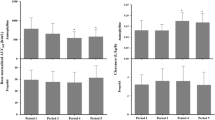Summary
Since in a previous study (preliminary report) (18) the iv. administration of 15 mg × kg−1 of phenytoin (PNT) over 30 min in men produced toxic levels (25μg/ml), a smallerr iv. dose of 7 mg×kg−1 was given during anaesthesia to 80 patients under going craniotomy, for the prevention of post-operative seizures.
Plasma PNT concentrations were studied in 22 patients before its iv. infusion 20min, 40min, and 1, 2, 3, 5, 8 and 12 hours later.
Mean serum phenytoin levels were 9.3,31.9,27.8,25.5,19.4,17.2, 15.4 and 19.2* μg/ml respectively.
In this study it appeared that although the initial dose was 50% smaller than before, toxic levels were still encountered one hour after PNT administration (therapeutic range 10–25 μg/ml). Bearing in mind that in both our studies PNT appeared to have approximately the same efficacy in seizure prevention (from 95–97%), we suggest, that 7–10mg × kg−1 would be adequate if administered as an intraoperative iv. infusion over an hour and that whenever possible serial serum levels should be monitored.
Similar content being viewed by others
References
Bell RD, Pac CYC, Zerwekh J (1979) Effect of phenytoin on bone and vitamin D metabolism. Ann Neurol 374–379.
Durelli L, Mutani R, Sechi Pet al. (1985) Cardiac side effects of phenytoin and carbamazepine. Arch Neurol 42: 1067–1068.
Johnson AL, Harris P, Blackwood DHR, Kalbag RM (1983) Phenytoin prophylaxis for posttraumatic seizures. J Neurosurg 59: 727–731.
McDonald RL, McLeavy MJ (1982) Cellular base of barbiturate and phenytoin anticonvulsion. Drug Action Epilepsia 23 (Suppl 1), S7-S18.
McLain LW, Martin TJ, Allen JH (1980) Cerebral degeneration due to chronic phenytoin therapy. Ann Neurol 7: 18–23
North JB, Penhall RK, Haniel A (1980) postoperative epilepsy: A double blind trial of phenytoin after craniotomy. Lancet 1: 384–386.
Penhall BJ, Penhall KR, Hamich A, Frewin DB, Taylor WB (1980) Phenytoin and postoperative epilepsy. Lancet 1: 650.
Olanow CW, Finn AL (1981) Phenytoin pharmacokinetics and clinical therapeutics. Neurosurgery 8: 112–117
Raport LR, Penry KJA (1973) Survey of attitudes toward the pharmacological prophylaxis of Posttraumatic epilepsy. J Neurosurg 38: 159.
Richardson AE, Uttley D (1980) Prevention of postoperative epilepsy. Lancet 1: 650.
Rish BL, Careness WF (1973) Relation of propylactic medication to the occurrence of early seizures following craniocerebral trauma. J Neurosurg 38: 155–158.
Rose J, Valtonen S, Jennett B (1977) Avoidable factors contributing to death after head injury. Br J Med 2: 615–618.
Royal College of Physicians of London (1977) Clinicopathological conference: Diagnostic difficulties in a case of polypharmacy. Br J Med 1: 213–216.
Small JM, Woolf AL (1957) Fatal damage to the brain by epileptic convulsions after a trivial injury to the head. J Neurol Neurosurg Psychiatry 20: 293–301.
Swaiman KF, Neale EA, Schrier KB, Nelson PG (1982) Toxic effect of phenytoin amd carbamazepine. Arch Neurol 13: 48–52.
Wilder BJ, Ramsey RE (1977) Efficacy of intravenous phenytoin in the treatment of status epilepticus. Kinetics of C.N.S. penetration. Ann Neurol 2: 511–518.
Wohns NWR, Wyler RA (1979) Prophylactic phenytoin in severe head injuries. J Neurosurg 51: 507–509.
Yannacou-Peftoulidou M, Tsolaki M, Sariyannis G, Votsis I, Anastasiou E, Sofianos E (1984) Plasma levels of phenytoin after intraoperative intravenous administration for the prophylaxis of epilepsy following craniotomy. (Preliminary report.) Acta Anaesth Hell 18: 236.
Young B, Rapp RP, Pharm D, Norton JA, Haack D, Tibbs PA, Bean RJ (1983) Failure of prophylactically administered phenytoin to prevent early posttraumatic seizures. J Neurosurg 58: 231–235.
Young B, Rapp RP, Pharm D, Norton JA, Haack D, Tibbs PA, Bean RJ (1983) Failure of prophylactically administered phenytoin to prevent late posttraumatic seizures. J Neurosurg 58: 236–241.
Author information
Authors and Affiliations
Rights and permissions
About this article
Cite this article
Tsolaki, M., Yannacou-Peftoulidou, M., Grammaticos, P. et al. Phenytoin plasma levels after intraoperative administration, for the prevention of post-craniotomy seizures. Acta neurochir 84, 36–38 (1987). https://doi.org/10.1007/BF01456348
Issue Date:
DOI: https://doi.org/10.1007/BF01456348




